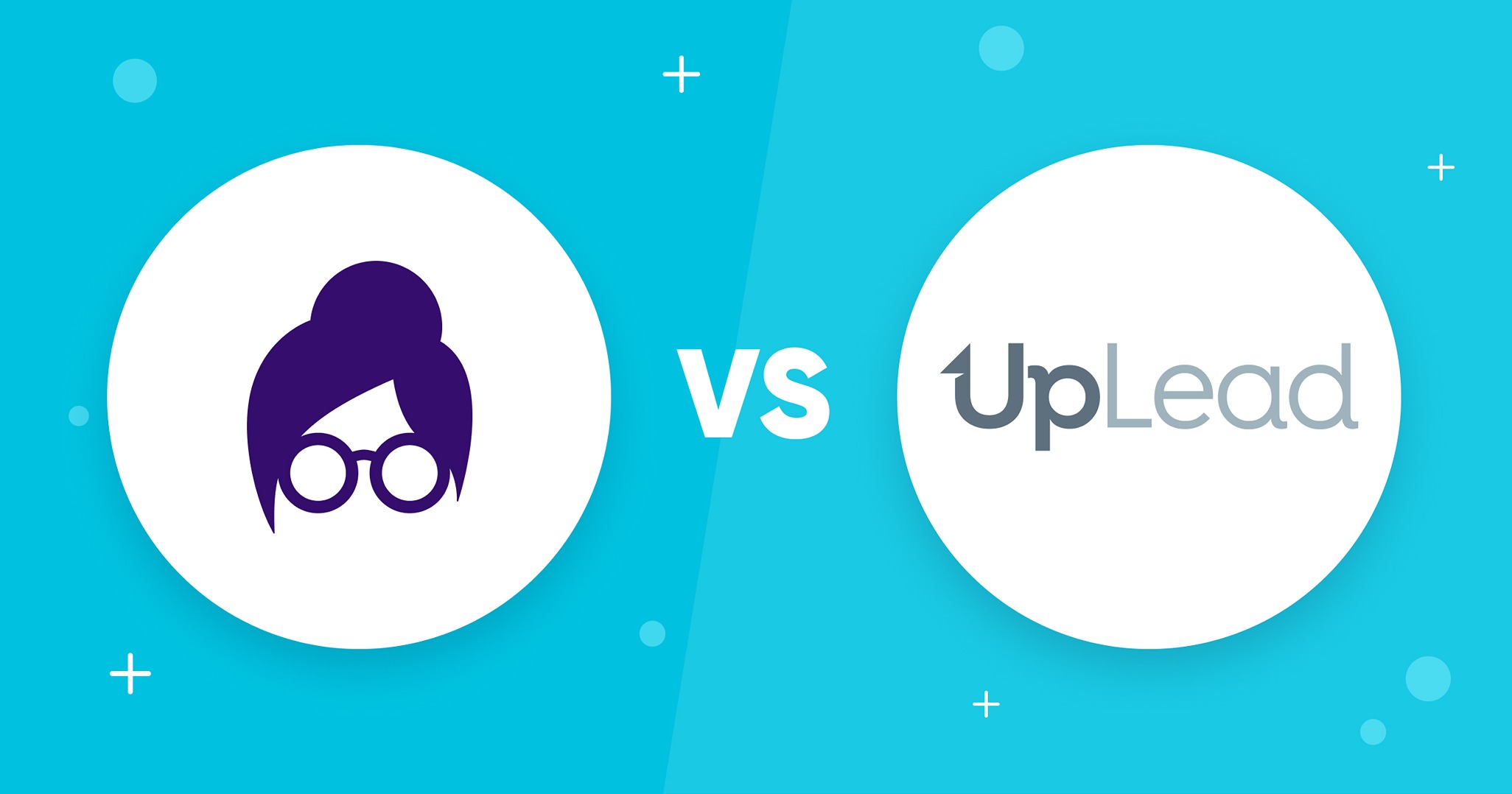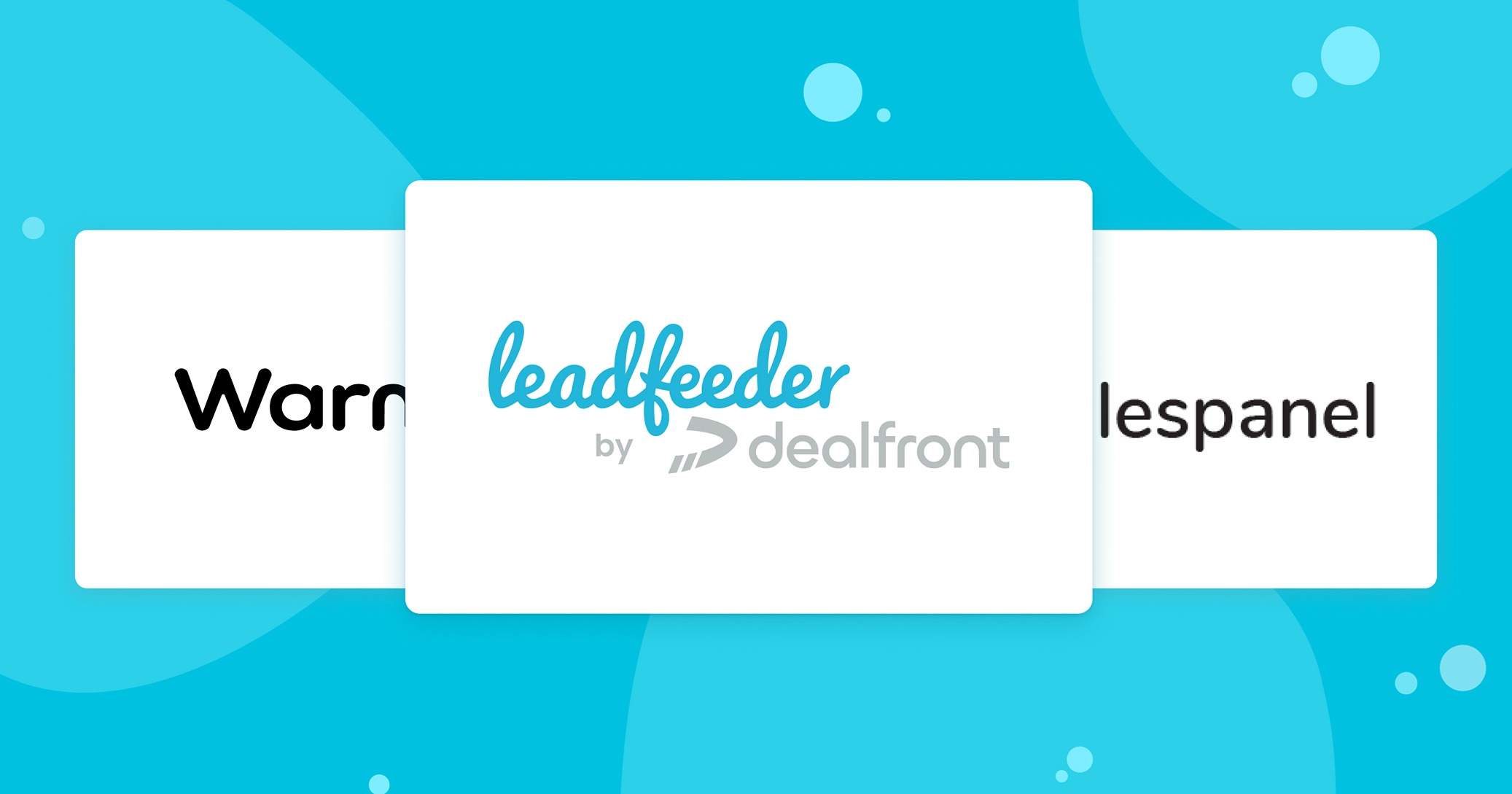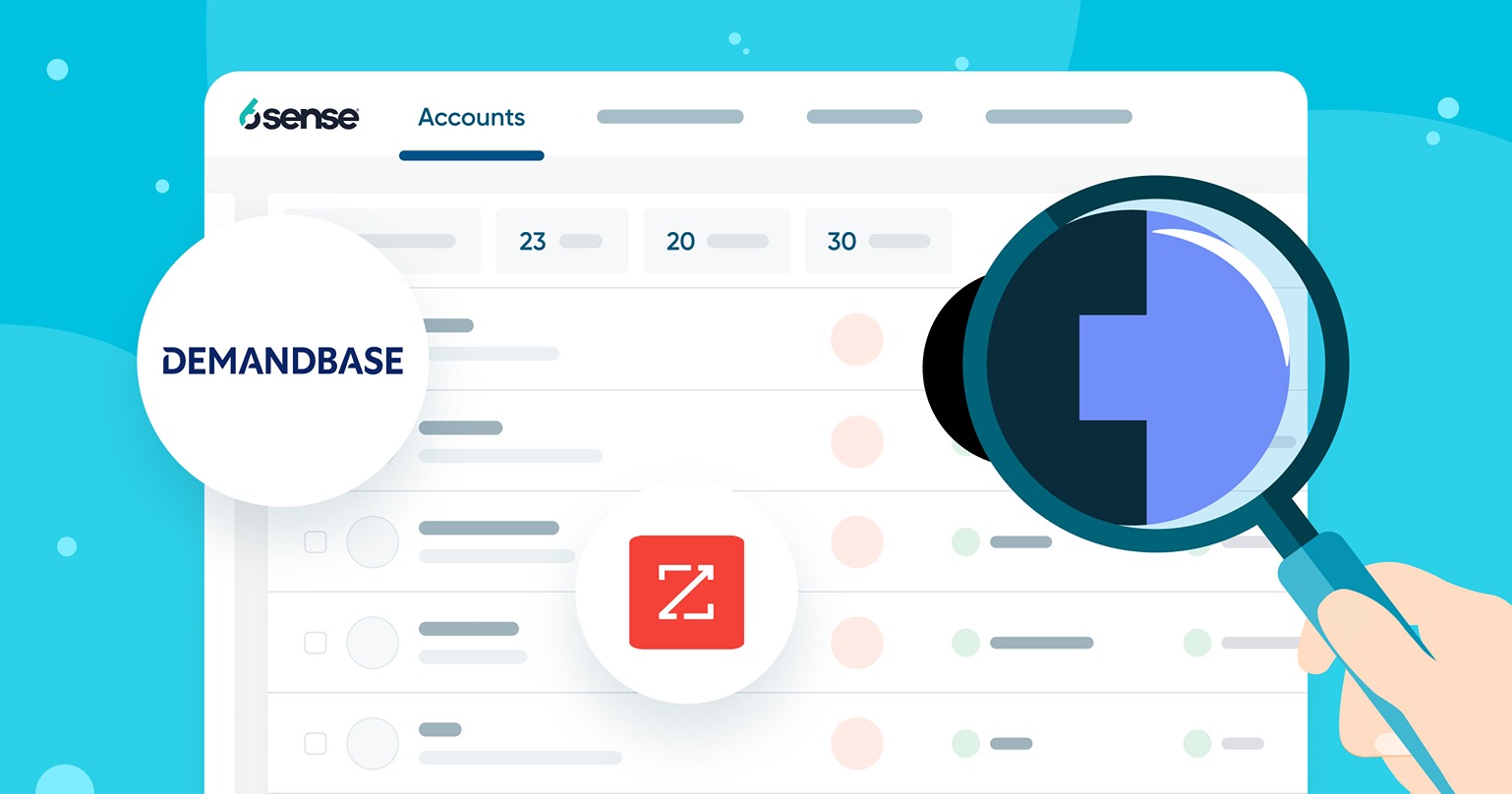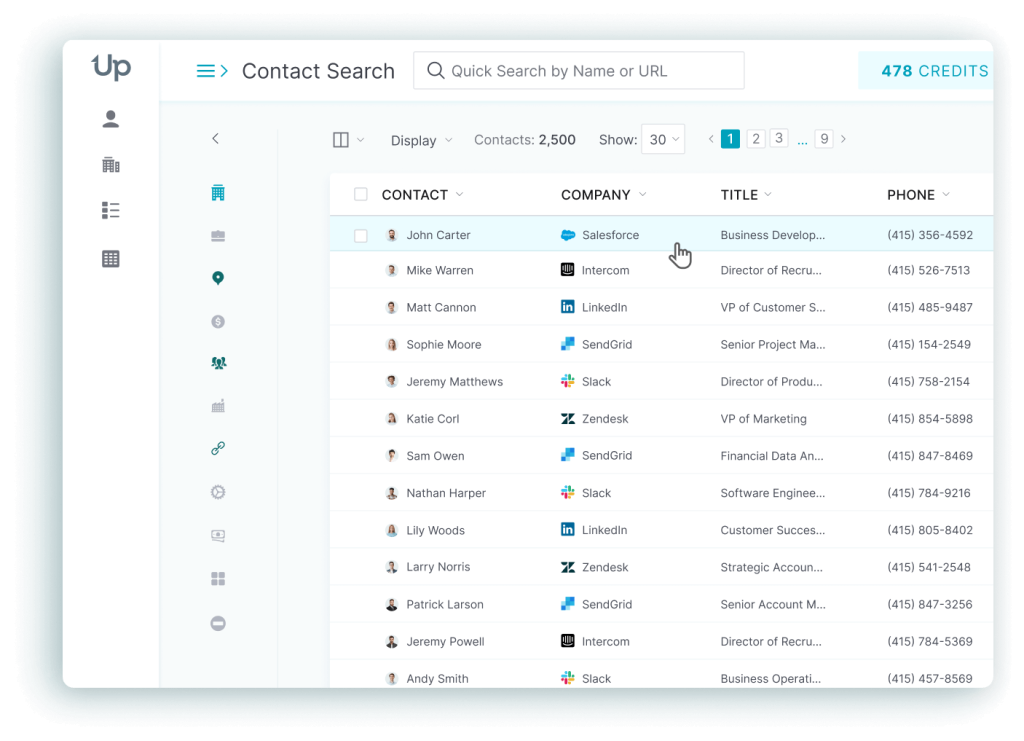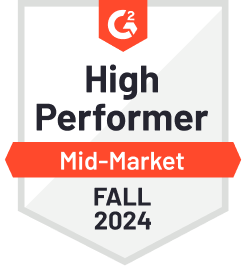Companies today live or die by their data. It’s that simple. But having mountains of information doesn’t help if you can’t trust it—or don’t know how to use it effectively.
Customer data reveals crucial insights throughout your business, showing you where sales opportunities exist, which marketing campaigns actually work, how to position your offerings, and where to focus your strategic efforts.
The real challenge? Quality. When your data is wrong, outdated, or inconsistent, your decisions suffer. Even databases you consider “clean” typically have room for significant improvement.
This is precisely why data enrichment matters—and why so many organizations have found tremendous value in UpLead’s solutions.
In the following sections, we’ll break down what data enrichment actually means, why it delivers real business impact, and what makes UpLead stand out as a preferred B2B data enrichment provider.
First, let’s dive into what data enrichment is, why it’s crucial for modern-day sales, and why UpLead is among the top-rated B2B data enrichment providers.

What Is Data Enrichment?
Data enrichment is the process of adding relevant, verified information to an existing database to enhance its accuracy and utility. So much raw data is produced and collected every day that it’s essential to constantly check, update and revise existing databases.
If you want to expand and improve the accuracy of your customer data and utilize it for sales prospecting, for instance, you need to continually update and refine that data. This supplemental data is taken from either internal or third-party sources, verified by your teams, and then “launched” as part of your updated database.
Through this process, you can ensure that your customer data is not only accurate and up-to-date, but it also accurately reflects your target audience.
The process falls in line with an idea once posited by Carly Fiorina, former CEO of Hewlett-Packard and the first woman to lead a Fortune Top-20 company: “The goal is to turn data into information, and information into insight.”
Enriching the data is a central part of that process.
Key Benefits of Data Enrichment
Data enrichment offers several key benefits for organizations of all sizes, which is why businesses should incorporate it into all levels of their operations. Some of these key benefits of data enrichment include:
- Reduced data redundancy: Redundant data can be very costly and damage your organization’s reputation, which can lead to lost customers and lost revenue. Data enrichment cross-references data sources and ensures that redundant data is effectively removed.
- Better data quality: Not only does data enrichment remove redundant data, but it adds new raw data from third-party sources and cross-references the current data you have. This enhances the quality of your data, since it’s more accurate and includes more data points, which helps to expand your knowledge about individual customers or customer segments.
- Cost savings: In 2018, consulting company Gartner estimated that low-quality data costs organizations $15 million on average every year. Data enrichment clears up storage space by removing irrelevant or inactionable data, focusing instead on enhancing the raw data that is useful. It also streamlines sales processes so salespeople can spend more time on actively prospecting leads rather than searching through them.
- Improved sales process: Cleaner data leads to an improved sales process. Through data enrichment, organizations can segment existing databases to create highly-targeted marketing and sales campaigns that are informed by refined data sets rather than theoretical ones.
- Customer nurturing: Data enrichment makes it easier for organizations to identify customer segments that require more nurturing. With more accurate and comprehensive data, it’s easier and quicker to glean valuable information that leads to conversions—including whether the best way to nurture that segment is through email, social media or other means.
- Customer relationships: When you have a breadth of accurate data, you can more easily personalize communication with customers, establishing more meaningful relationships and leading to increased loyalty and trust.
Case Studies of Data Enrichment
The benefits of customer data enrichment outlined above demonstrate its value, but examining specific examples in more detail can help you understand how your organization can effectively integrate it into its processes. Here are some example case studies of how data enrichment can be useful for data analysis and other processes.
Customer Segmentation
Staffing Future, a software recruiting company, faced challenges in effectively segmenting prospects due to the limited availability of prospect data. They implemented UpLead’s technographic segmentation capabilities to enrich their prospect database with detailed technology usage information and firmographic details such as job title, industry, geographic location, management level and employee count.
With this enriched data, Staffing Future precisely segmented prospects and executed highly targeted email outreach campaigns explicitly tailored to each segment’s technology stack. Within just 30 days of using UpLead’s enriched lead segmentation data, Staffing Future closed $20,000 in new business, achieving an impressive ROI of 1,567%. Additionally, 90% of initial prospect conversations were directly driven by the enriched leads provided by UpLead.
Check out the case study here.
App Usage Analysis
Slack enriched its user analytics by integrating detailed app usage data such as total messages sent, active users per day, reaction counts, and channel engagement metrics. By analyzing these enriched insights, Slack identified clear patterns correlating certain behaviors—such as frequent channel interactions and use of integrations—with higher long-term retention rates.
This precise behavioral insight empowered Slack administrators to optimize onboarding processes and encourage new users to adopt key features earlier. As a result, organizations using Slack’s analytics-driven recommendations reported measurable improvements in user retention and overall platform engagement.
Lead Scoring
Retable, a UK-based work management platform, faced challenges in identifying high-intent leads among numerous daily inbound prospects.
By integrating data enrichment services, Retable automated the process of appending detailed firmographic and behavioral data to each lead. This enhancement enabled the implementation of a predictive lead scoring model, allowing its sales team to prioritize engagement with the most promising leads.
Consequently, Retable experienced a significant improvement in conversion rates and overall sales efficiency.
| Example | Data Enrichment Action | Measurable Results |
| Staffing Future Lead Segmentation | Technographic & firmographic enrichment for precise lead targeting | $20,000 closed in first month; ROI of 1,567% |
| Slack User Engagement | Integrated detailed app usage metrics into analytics | Improved retention rates and higher platform engagement |
| Retable Lead Identification | Automated enrichment of new signups with firmographic and behavioral data | Significant improvement in conversion rates and overall sales efficiency |
Breaking Down the Data Enrichment Process: A Step-by-Step Guide
Data enrichment transforms your basic contact lists into powerful business assets. While it may sound complex, following a structured approach makes the process straightforward and highly effective. So, how can you start this process? Follow this practical yet comprehensive guide to begin enriching your B2B data as soon as today:
Step 1: Assess Current Data Set
The first step is evaluating what you currently have. This isn’t just about counting records; it’s about understanding the quality and completeness of your existing data.
Practical Example:
A sales team at a SaaS company reviews their CRM. They find that, while they have contact names and company names for 5,000 prospects, they are missing crucial data such as:
- Job titles (for 40% of contacts)
- Company size (for 65% of companies)
- Industry classifications (for 30% of companies)
- Direct phone numbers (for 75% of contacts)
Without this information, they can’t effectively segment their audience or personalize their outreach. If you were tasked with enriching the data for the sales team, here’s how to do it.
Action Steps:
- Export your contact list from your CRM.
- Run a data completeness analysis (most CRMs offer this feature) or simply export your list as a CSV to Excel or a similar spreadsheet program.
- Identify critical fields with the highest percentage of missing data by filtering for empty fields.
- Determine which missing data points are most crucial for your sales efforts.
Step 2: Data Cleansing
Before enriching your data, you need to clean what you already have. This means removing duplicates, standardizing formats, and correcting obvious errors.
CRM Cleaning Examples:
- In Salesforce: Use Data.com Clean to identify and merge duplicate records.
- In HubSpot: Use the duplicate management tool to find and merge contacts.
- In Pipedrive: Export contacts, use the built-in duplicate finder, then re-import clean data.
Action Steps:
- Remove duplicate contacts by comparing email addresses and names.
- Standardize company names (e.g., “IBM Corp” and “International Business Machines” both become “IBM”).
- Correct formatting issues such as capitalization inconsistencies or improper phone number formats.
- Archive contacts with critical missing information that can’t be enriched.
Step 3: Incorporate Additional Data Sources
This is where UpLead becomes essential. The platform allows you to enhance your existing data with accurate, up-to-date information from multiple verified sources.
Here’s how you can use UpLead’s Data Enrichment feature to enrich your contact lists:
1. Navigate to the Enrich section in the left sidebar
2. Choose to enrich either Contacts or Companies
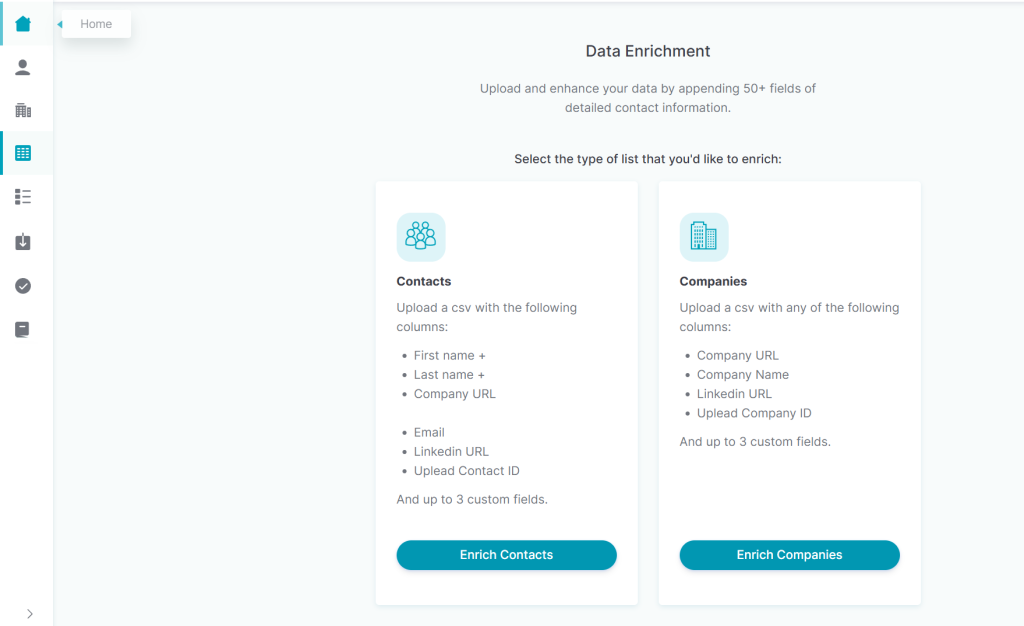
3. Upload your contacts or companies CSV file:
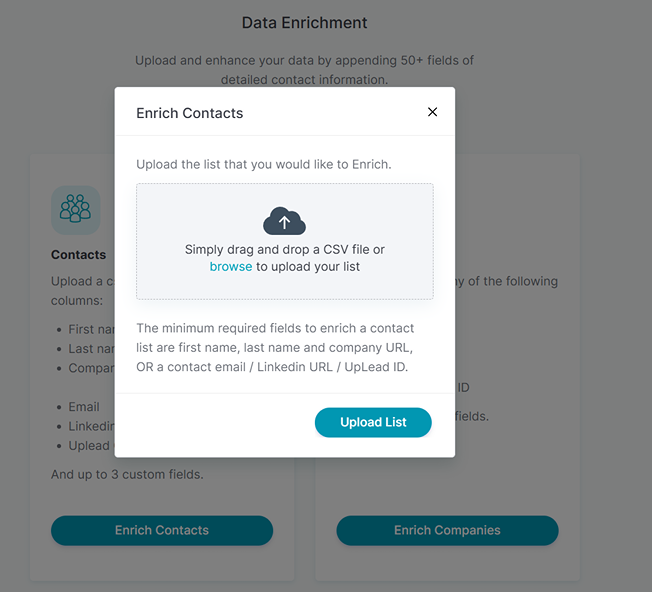
4. Map your CSV fields to UpLead fields, optionally add verification, and click on Start Enrichment to start the process.
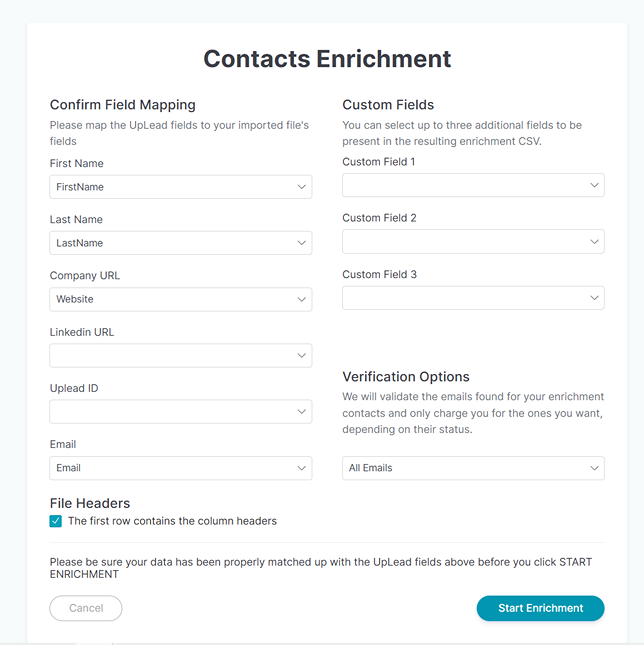
5. Access your enriched data under the Downloads section when complete.
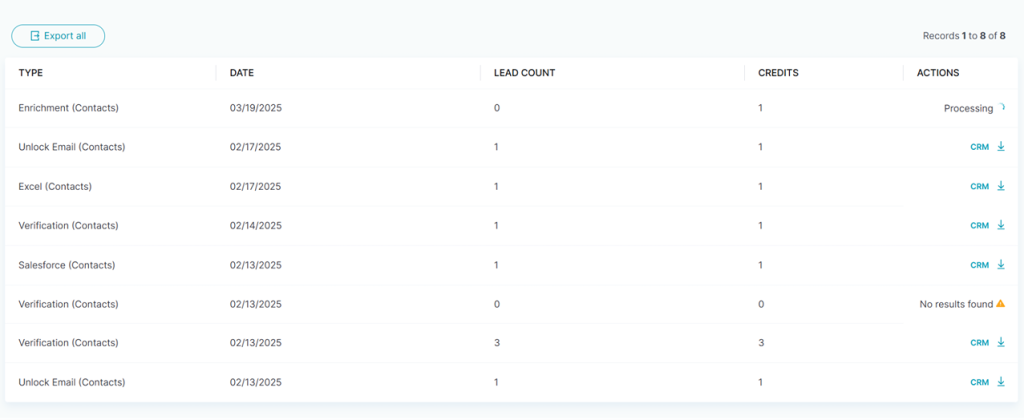
Step 4: Data Validation and Contact Verification
After enrichment, it’s crucial to validate the new data. UpLead handles much of this automatically with its real-time verification system.
UpLead’s Verification Process:
- When you unlock a lead’s contact information, UpLead verifies the email address in real-time.
- The system provides verification statuses: Valid (97%+ verified), Invalid, or Accept All.
- Records with invalid email addresses are automatically sent to UpLead’s research team for updating.
Action Steps:
- Review your enriched data for any obvious inconsistencies.
- Perform spot checks on a sample of records to ensure accuracy.
- If using multiple data sources, cross-reference information for consistency.
- Upload your verified data to your CRM.
Step 5: Maintaining Enriched Data
Data enrichment isn’t a one-time project; it’s an ongoing process that requires regular maintenance to remain valuable.
Establish a Regular Enrichment Routine:
- Schedule monthly data quality reviews in your CRM.
- Set up automated data enrichment every quarter using UpLead.
- Implement a data decay alert system to flag records that haven’t been updated in more than six months (or a timeframe of your choosing).
- Create a process for sales team members to flag outdated information they encounter.
Automated Maintenance with UpLead:
- Schedule recurring data enrichment tasks.
- Set up API integrations for real-time data updates.
- Use UpLead’s Chrome extension to update contact information while browsing LinkedIn.
- Create alerts for when key prospects change companies or positions.
Step 6: Integrating Data Into Your Business
The final step is putting your enriched data to work across your organization.
You can use UpLead’s direct CRM integrations to push enriched data to CRMs such as Salesforce, HubSpot, Pipedrive, Zoho CRM, or Microsoft Dynamics. Then, set up field mappings to ensure data lands in the right places.
Beyond CRM Integration:
- Marketing Automation: Feed enriched data to your marketing platform to power advanced segmentation and personalization.
- Example: Target prospects from specific industries with tailored content.
- Sales Intelligence: Create custom views for sales teams based on enriched data.
- Example: Create a dashboard that highlights prospects at companies with revenue above $50M and recent funding announcements.
- Account Planning: Use firmographic data to identify ideal customer profiles.
- Example: Analyze enriched data to discover insights—for instance, that your best customers are in the financial services sector with 100-500 employees.
- Territory Planning: Leverage location data for strategic territory assignments.
- Example: Reassign prospects based on newly-enriched geographic information.
By following these six steps with UpLead, you’ll transform raw contact lists into a strategic asset that drives revenue growth across your entire organization.
Use Cases for Enriched Data: Practical Implementation with UpLead
There are so many use cases for enriched data, some of which are specific to individual organizations or industries. That being said, here are some common and popular use cases.
Personalized Communication
Enriched data enables businesses to deliver highly personalized customer experiences.
For example, Domino’s Pizza partnered with Conversant to leverage enriched first-party transaction data for personalized advertising campaigns. By identifying consumer preferences and targeting them at scale, Domino’s achieved a 10:1 incremental return on ad spend, generating more than £1 million in revenue.
Want to achieve a similar outcome with your business? UpLead makes the process simple with its all-in-one B2B data platform.
Follow this process in UpLead:
- Identify Needs: Export CRM contacts; select fields (job titles, industries, company size).
- Enrich Data: Navigate to Enrich → Choose Contacts or Companies → upload CSV → map fields and start enrichment
- Create Segments: Download enriched data; import into CRM; segment by enriched fields (e.g., “VPs at Enterprise Tech Companies”).
- Personalize Outreach: Use dynamic fields in email templates. Automate personalized sequences.
Here’s an example of a personalized email template you could use for your outreach campaign:
“Hi {First Name}, noticed your role as {Job Title} at {Company Name} and your team’s growth to around {Company Size} employees. Our platform has helped similar companies in {Industry} achieve significant improvements. Could we schedule 15 minutes to discuss potential benefits?”
Targeted Marketing
Targeted marketing campaigns thrive on enriched data, which enables the identification of specific audience segments and the tailoring of messages accordingly.
For instance, EasyJet used enriched customer data to create personalized email campaigns highlighting each customer’s travel history with the airline and suggesting future destinations. This campaign led to a 7.5% booking rate within 30 days and overwhelmingly positive customer feedback.
Here’s how to get started on a similar process:
- Define Target Segments: Identify ideal contact attributes (industry, job title, company size etc.).
- Filter Contacts in UpLead: Use UpLead’s Contact Search tool to filter contacts based on company criteria like industry, revenue, and technologies used.
- Export Targeted Lists: Export filtered contacts directly from UpLead to your CRM.
- Launch Campaigns: Import data into your CRM or marketing automation platform; create tailored emails and landing pages for each segment and track your campaign performance.
Informed Decision-Making
Enriched data provides the foundation for strategic decision-making by offering accurate insights.
Take Netflix, for example: The streaming service uses enriched data from user viewing habits, ratings, and search behavior to recommend content tailored to individual preferences. This approach has enhanced user retention and increased viewing time. Even if your industry and business model is different, you can similarly use data insights to drive strategy.
Here’s how you can use enriched data to make informed decisions about specific markets:
- Strategic Data Identification: Define key business questions and determine supporting data points.
- Comprehensive Enrichment: Use “Companies” enrichment on UpLead for detailed market insights.
- Create Dashboards: Import enriched data into BI tools (PowerBI, Tableau); visualize market penetration, deal sizes, and technology adoption.
- Drive Strategy: Use enriched insights to prioritize product development, identify integration opportunities, optimize pricing, and refine territory assignments.
- Regular Updates: Schedule quarterly enrichments.
Best Practices for Data Enrichment
If you’re unsure where to begin, follow these best practices for data enrichment to ensure a smooth process and optimal results.
- Set goals: Any business undertaking should include specific goals. For data enrichment, it’s important to choose clear, defined, and measurable objectives, such as filling in demographic gaps that exist in your current set.
- Find quality sources: Data is only as reliable as its sources. Use verified datasets from trusted providers. For instance, UpLead cross-references data from multiple sources (including government records and industry databases) to ensure accuracy rates above 95%. Always validate external data against these trusted benchmarks.
- Constantly clean data: Data enrichment is a continuous process. Set up a process for how you will monitor, clean, verify, and update your data to ensure it remains of high quality—all of which UpLead can handle for you.
- Use the best tools: Your data enrichment process can be enhanced and entirely run by comprehensive B2B platforms such as UpLead. The tools can cross-reference your sources and enhance the datasets you have, expanding their value.
- Automate where possible: Leverage technology such as machine learning and AI wherever possible to help you automate the process. UpLead has these technologies built into its platform.
- Protect privacy: Any time you’re dealing with customer data, it’s essential that you’re protecting people’s privacy. Make sure that you have the permissions necessary to collect the data and then use it, and put in place security measures that will protect it.
UpLead Is the Best B2B Data Enrichment Tool
Data enrichment is a vital process that all organizations must undertake, and UpLead is the leading B2B data enrichment tool on the market. Not only do we provide you with access to real-time verified B2B emails, mobile numbers, and intent data—all of which can help power your business to make more informed decisions—but we also guide you through the process from start to finish.
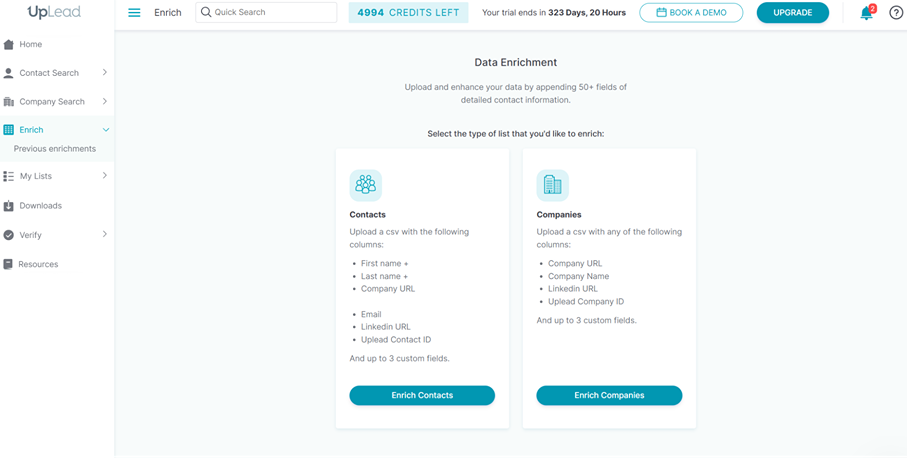
Simply upload your current datasets and let the platform go to work enriching your data. What results is more accurate, up-to-date, and usable data that can fuel your organization’s growth.
Want to learn more and try it for yourself? Book a demo and sign up to start a free trial of UpLead today.
FAQs About Data Enrichment
Data enrichment involves augmenting your existing data with new details that are relevant from many other sources. It results in more robust, accurate, and up-to-date datasets that you can utilize.
Data cleansing is just one step of the process. It removes inaccurate data, while the entire data enrichment process enhances the data you have.
When data is enriched, it is enhanced thanks to additional information that has been imputed from multiple external sources. In essence, enriched data is more valuable and comprehensive.
Data enhancement is the process of refining your current datasets. This is achieved by incorporating additional data from external sources to enhance the existing data.
Data enrichment ensures that the data you have is accurate, up-to-date and, most importantly, usable. It provides a wealth of benefits to any organization.
A data enrichment specialist is a company, tool, platform, or person who focuses on taking an organization’s existing data and enhancing its quality. Platforms like UpLead specialize in this, making the data enrichment process more effective and efficient for businesses.
Data enrichment is legal, although there may be certain limitations on how you can use this data or access it. Data enrichment in and of itself isn’t in violation of privacy laws, though organizations need to put proper security measures in place to ensure privacy is protected.
Get Started on Your Data Enrichment Journey
Data enrichment is a process that all organizations should undertake to ensure their data is up-to-date and accurate. By integrating new datasets and verifying them against reliable sources, you can make sure that your business stays ahead of the curve.
UpLead can help with your data enrichment efforts. Contact us today to learn more.

